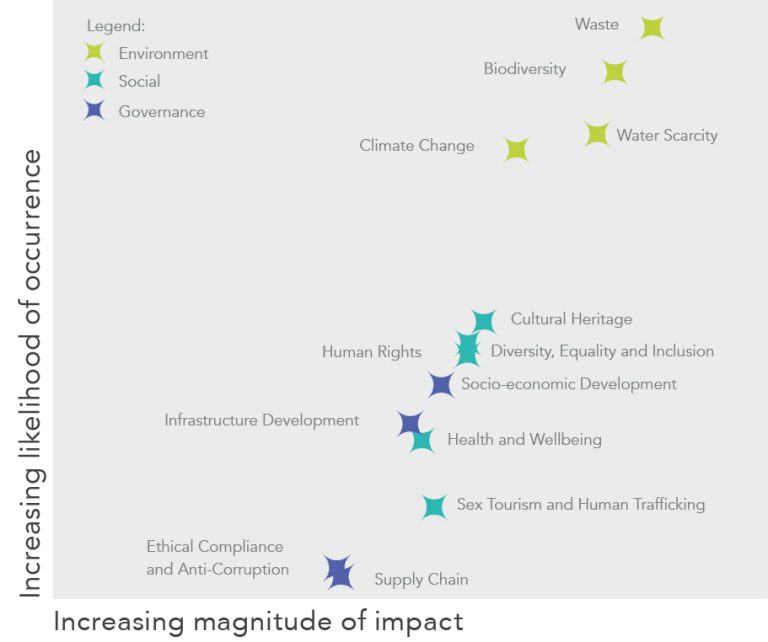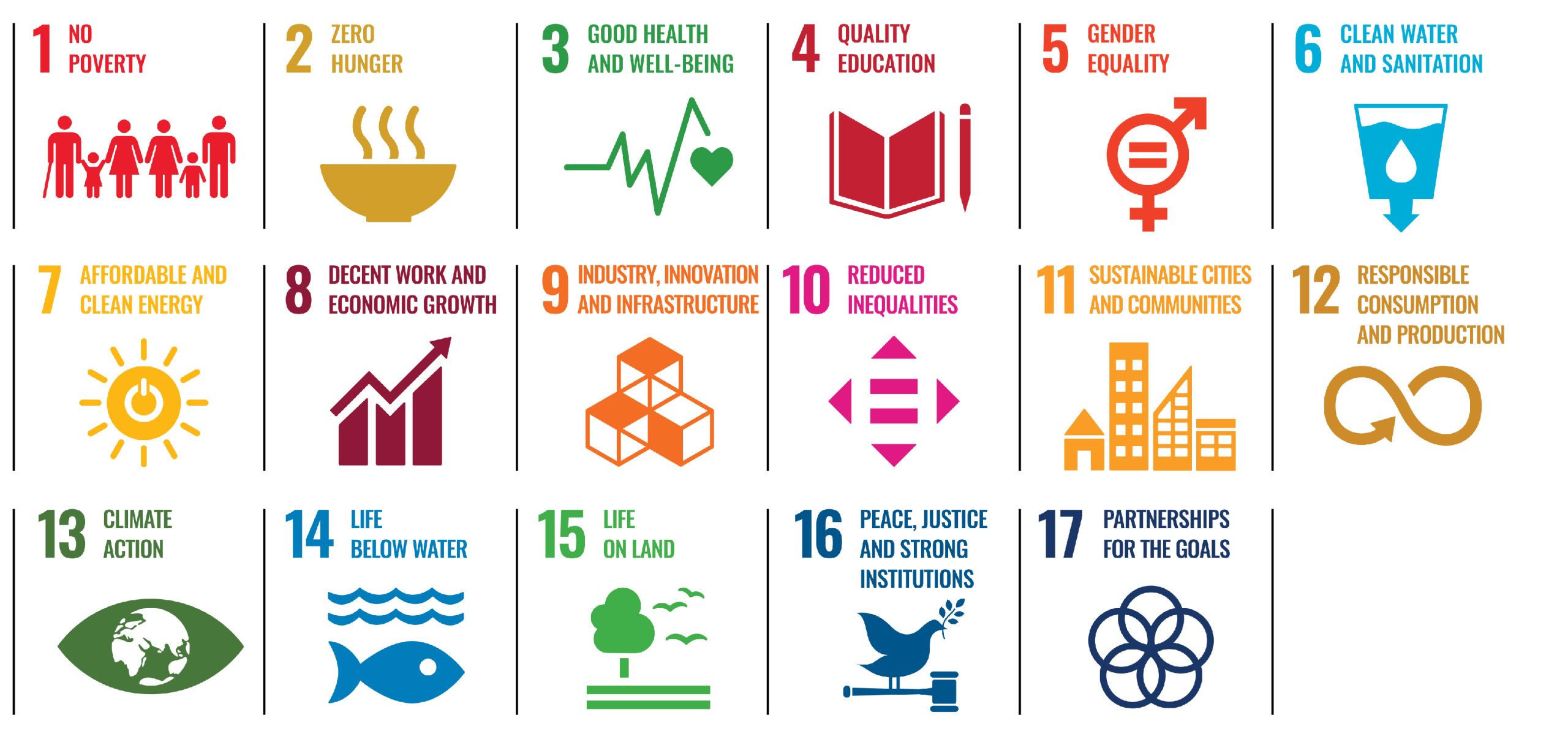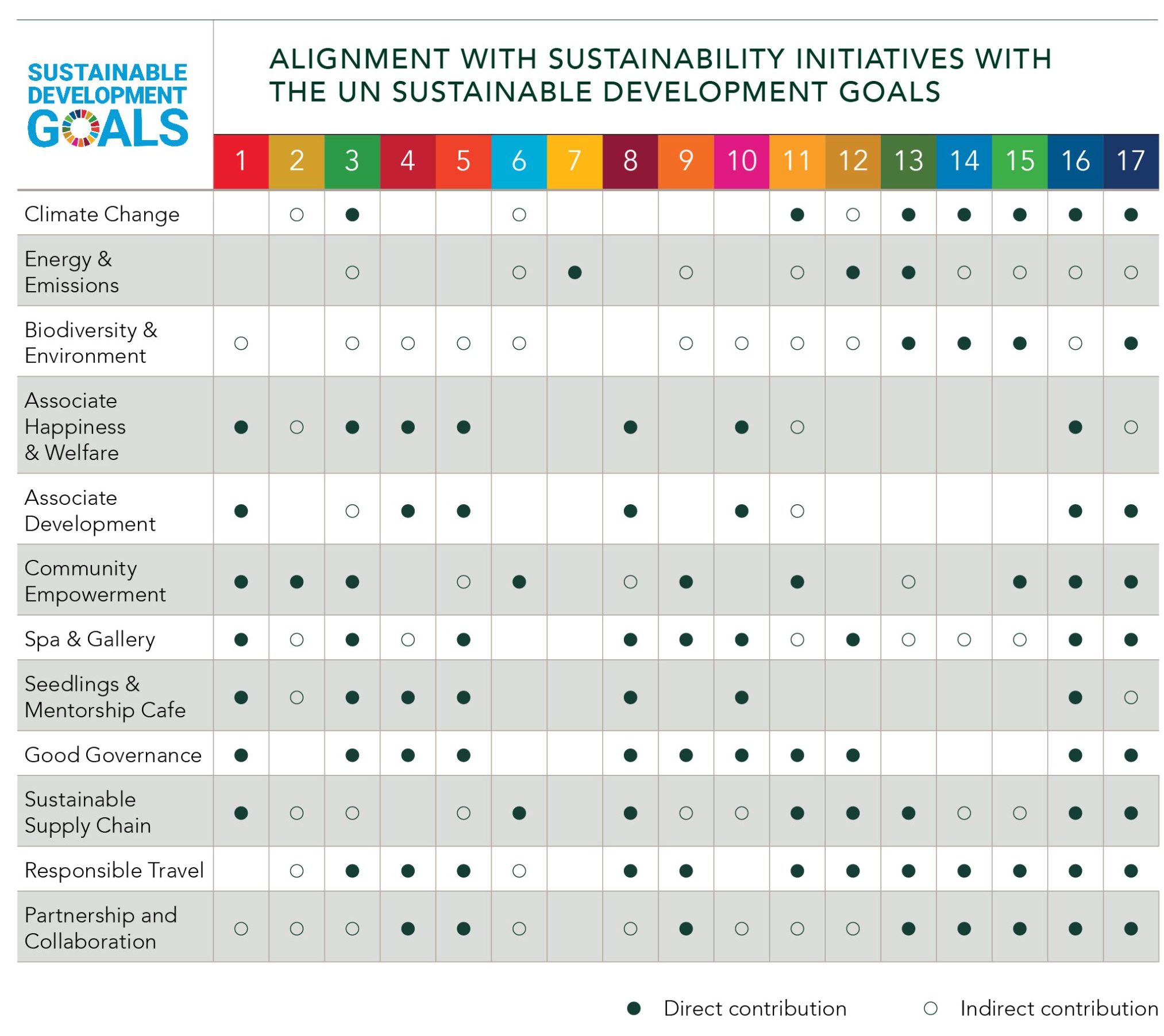APPENDIX
As pioneers of sustainable tourism, we serve as stewards of the environment and communities, and act in an ethical and accountable manner.
MATERIAL TOPICS
MATERIALITY: WHAT WE MEASURE, MANAGE AND MITIGATE
In 2022, we developed strategies, established baselines, drafted policies and new procedures to support implementation of the materiality assessment we completed at the end of 2021. Executive management presented these to the Board, refined them based on the directors’ feedback, and obtained the Board’s approval.The process by which we renewed materiality was as follows:
- We reviewed published academic literature, competitor and industry reports to incorporate emerging material risks.
- Executive management approved for prioritisation a shortlist of 14 existing and emerging environmental, social and governance (ESG) material risks pertinent to our business.
- The severity and likelihood of material risk impacts were rated following Global Reporting Initiative (GRI) (2021) guidance, via an online survey, with 659 senior and executive management respondents across Banyan Tree Group worldwide. Material topics were evaluated at the residual level, considering the adequacy and effectiveness of existing controls and progress, and comparing the impact of each topic from our business against other topics rather than within a global context that may not be within our control.
This framework provides the foundation of our efforts from 2022 to 2030. Regular reviews ensure it is current, meets stakeholder needs and promotes responsible travel. This report is the second for our current material topics. For each topic, we present its importance, its scope, our management approach, Key Performance Indicators (KPIs) and progress, in accordance with the reporting requirements of the Singapore Exchange (SGX) and referencing GRI standards.

We defined impact scope and developed mitigation strategies for the five greatest material risks from our business:
WASTE, BIODIVERSITY, WATER SCARCITY, CLIMATE CHANGE, AND DIVERSITY, EQUALITY AND INCLUSION.
LIST OF CORE ESG METRICS
Environmental
| Topic | Metric | Unit | 2023 Result | Framework Alignment |
| Greenhouse Gas Emissions (GHG) | Absolute emissions by: (a) Total; (b) Scope 1, Scope 2; and (c) Scope 3, if appropriate | tCO2e |
| GRI 305-1, GRI 305-2, GRI 305-3, TCFD, SASB 110, WEF core metrics |
| Emission intensities by: (a) Total; (b) Scope 1, Scope 2; and (c) Scope 3, if appropriate | tCO2e/organisation – specific metrics (note: metric is kg per occupied room) | Total 159 KgCO2e Per Occupied Room | GRI 305-4, TCFD, SASB 110 | |
| Energy Consumption | Total energy consumption | MWhs or GJ | 236,780,000 KwH | GRI 302-1, TCFD, SASB 130 |
| Energy consumption intensity | MWhs or GJ/organisation – specific metrics | 152 KwH Per Occupied Room | GRI 302-3, TCFD | |
| Water Consumption | Total water consumption | ML or m3 | 5,361,000 | CBM GRI 303-5, SASB 140, TCFD, WEF core metrics |
| Water consumption intensity | ML or m3/organisation – specific metrics | 3.44 CBM Per Occupied Room | TCFD, SASB IF-RE-140a.1 | |
| Waste Generation | Total waste generated | t | 12,582,105 KG | GRI 306-3, SASB 150, TCFD, WEF expanded metrics |
Social
| Topic | Metric | Unit | 2023 Result | Framework Alignment | |||
| Gender Diversity | Current Employees by gender | Percentage (%) | Total = 13,169 | M= 7,613 (57.8%) | F = 5,556 (42.2%) | GRI 405-1, SASB 330, WEF core metrics | |
| New hires and turnover by gender | Percentage (%) | New Hires: Turnover: | Male 54.5% 55.9% | Female 45.5% 44.1% | GRI 401-1, WEF core metrics | ||
| Associate Snapshot | Current employees by age groups | Percentage (%) | Job Level: Senior Management: Supervisor: Non-Supervisor: | <30 0.27% 2.09% 29.68% | 30-50 3.79% 15.59% 38.56% | >50 1.26% 1.40% 7.36% | GRI 405-1, WEF core metrics |
| New hires and turnover by age groups | Percentage (%) | New Hires: Turnover: | <30 51.8% 45.1% | 30-50 44.0% 48.6% | >50 4.2% 6.3% | GRI 401-1, WEF core metrics | |
| Employment | Total turnover | Number and Percentage (%) | 3,489 – 26.5% | GRI 401-1, SASB 310, WEF core metrics | |||
| Total number of employees | Number | Total = 13,169 | GRI 2-7 | ||||
| Development & Training | Average training hours per employee | Hours/No. of employees | 7.06 hours per month | GRI 404-1, WEF core metrics | |||
| Average training hours per employee by gender | Hours/No. of employees | M = 528,040 | F = 476,138 | GRI 404-1, WEF core metrics | |||
| Occupational Health & Safety | Fatalities | Number of cases | 1 | GRI 403-9, WEF core metrics, MOM (Singapore), SASB 320 | |||
| High consequence injuries | Number of cases | 7 | |||||
| Recordable injuries | Number of cases | 436 | |||||
| Recordable work-related ill health cases | Number of cases | 84 | GRI 403-10, WEF expanded metrics, MOM (Singapore) | ||||
Governance
| Topic | Metric | Unit | 2023 Metric | Source |
| Board Composition | Board independence | Percentage (%) | 55% | GRI 2-9, WEF core metrics |
| Women on the board | Percentage (%) | Our current Women On Board (WOB) percentage of 18% is close to the 25% target set by the Council of Board Diversity. Our WOB percentage for Independent Directors is 33% | GRI 2-9, GRI 405 – 1, WEF core metrics | |
| Management Diversity | Women in the management team | Percentage (%) | Use JG3 and above as reported already in the SR | GRI 2-9, GRI 405-1, WEF core metrics, SASB 330 |
| Ethical Behaviour | Anti-corruption disclosures | Discussion and number of standards | 98.4% of all associates signed the Code of Conduct declaration. | GRI 205-1, GRI 205-2 and GRI 205-3 |
| Anti-corruption training for employees | Number and Percentage (%) | 10,861 Associates or 92.02% | GRI 205-2, WEF core metrics | |
| Alignment with the framework | Alignment with the framework and disclosure practices | GRI/TCFD/SASB/ SDGs/ others | SDG TCFD | SGX-ST Listing Rules (Mainboard) 711A and 711B, Practice Note 7.6; SGX-ST Listing Rules (Catalist) 711A and 711B, Practice Note 7F |
Alignment with The United Nations Sustainable Development Goals
Our planet is undergoing unprecedented global societal and environmental change. To address and combat this, the United Nations Sustainable Development Goals (SDGs) define priorities and set ambitious global targets for 2030 to combat poverty, inequality and tackle climate change.

Aligning our efforts with the SDGs helps us contribute towards supporting social and environmental challenges that cannot succeed without each other. Through our new materiality analysis, we have identified areas of impact on which to focus our efforts, scale up positive impacts, and reduce or avoid negative impacts. Our efforts directly and indirectly contribute towards the SDGs as shown.
Specific calls to tourism: SDGs 8, 12 and 14.
1–12: Social
13–15: Environmental
16–17: Peace & Partnership
Task force for climate-related financial disclosures (tcfd) content index
Task Force on Climate-Related Financial Disclosures (TCFD)
The below maps the steps Banyan Group is taking against the 11 recommended disclosures across 4 recommendations of the TCFD.
| Disclosure | Steps Banyan Group is taking | ||||||||||||||||||||||
| GOVERNANCE | |||||||||||||||||||||||
| Describe the board’s oversight of climate related risks and opportunities. |
|
||||||||||||||||||||||
| Describe management’s role in assessing and managing climate related risks and opportunities. |
|
||||||||||||||||||||||
| STRATEGY | |||||||||||||||||||||||
| Describe the climate related risks and opportunities the company has identified over the short, medium, and long term. |
|
||||||||||||||||||||||
| Describe the impact of climate-related risks and opportunities on the company’s businesses, strategy, and financial planning |
|
||||||||||||||||||||||
| Describe the resilience of the company’s strategy, taking into consideration different climate-related scenarios, including a 2°C or lower scenario. | With the identification of the climate risks and opportunities, we enhanced our understanding of how climate related risks and opportunities could affect our business and operations. We are in the midst of performing a business resilience assessment to better align ourselves for the future.
|
||||||||||||||||||||||
| RISK MANAGEMENT | |||||||||||||||||||||||
| Describe the company’s processes for identifying and assessing climate related risks. | The Group follows its Enterprise Risk Management Framework in identifying, assessing, and managing climate-related risks. Climate change is identified as a Tier 1 risk.
|
||||||||||||||||||||||
| METRICS AND TARGETS | |||||||||||||||||||||||
| Disclose the metrics used by the company to assess climate-related risks and opportunities in line with its strategy and risk management process. | The Group uses the following metrics: 1) energy use, 2) energy intensity, 3) emissions produced (Scopes 1, 2 and 3); 4) emission intensity; 5) water consumption; 6) waste management. Sustainability has been included as a key performance indicator for senior management. |
||||||||||||||||||||||
| Disclose Scope 1, Scope 2 and, if appropriate, Scope 3 greenhouse gas (GHG) emissions, and the related risks. | The total emissions for Banyan Group for 2023 was 296 KtCO2e. This is 9% higher than the emissions for 2022.
In 2023, our emission intensity per occupied room dropped by 22% to 159 kg CO2e. The increase in emissions is in line with revenue growth (21%) between 2022 and 2023.
|
||||||||||||||||||||||
| Describe the targets used by the company to manage climate-related risks and opportunities and performance against targets. | To be in line with Science Based Targets initiatives (SBTi), we have:
Targets
Progress:
2023 initiatives:
Next Steps:
|
||||||||||||||||||||||
